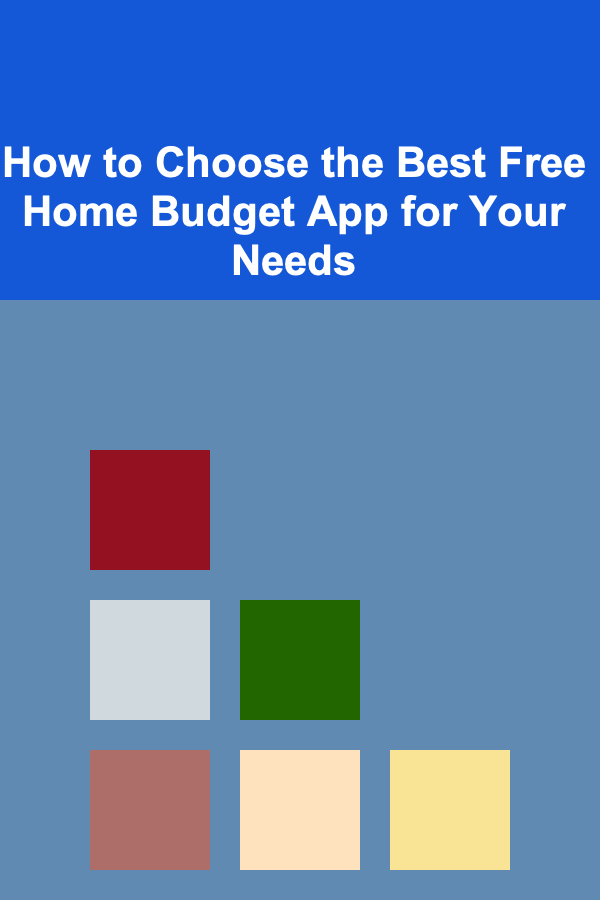
How to Choose the Best Free Home Budget App for Your Needs
ebook include PDF & Audio bundle (Micro Guide)
$12.99$5.99
Limited Time Offer! Order within the next:

In today's fast-paced financial environment, managing your personal finances effectively is more important than ever. With rising living costs and increasing complexities in financial obligations, having a clear understanding of your budget can provide peace of mind and help you achieve your financial goals. Fortunately, free home budget apps offer an accessible solution to track expenses, manage budgets, and save money. However, with so many options available, how do you choose the best one for your unique needs? This article will explore various criteria to consider when selecting a budgeting app, the features that can enhance your budgeting experience, and some popular options to consider.
Understanding the Importance of Budgeting Apps
The Role of Budgeting in Financial Management
Budgeting is the process of creating a plan to manage your income and expenditures. It allows you to allocate funds for necessities, discretionary spending, savings, and debt repayment. Budgeting apps play a crucial role in this process by providing tools to monitor and control your financial activities effectively.
Benefits of Using Budgeting Apps
- Real-Time Tracking: Many budgeting apps allow for automatic tracking of expenses linked to your bank accounts, meaning you can see your spending as it happens.
- Ease of Use: Most apps are designed with user-friendly interfaces that simplify budgeting even for those unfamiliar with financial management.
- Goal Setting: Budgeting apps often include features that let users set and track savings goals, making it easier to pursue financial ambitions.
- Visual Insights: Graphs and charts can illustrate your spending habits, helping you identify areas to improve upon.
- Accessibility: Cloud-based apps can be accessed from any device with internet connectivity, allowing for updates and reviews anytime.
- Security: Reputable budgeting apps use encryption to keep your financial information secure, giving you peace of mind.
Key Features to Consider When Choosing a Budgeting App
When evaluating budgeting apps, certain characteristics and functionalities can significantly impact their effectiveness for your personal financial situation. Here are key features to look for:
1. User-Friendly Interface
The app should have an intuitive design that is easy to navigate. If you find the app difficult to use, you're less likely to engage with it regularly. Look for apps that offer a clean layout with straightforward navigation.
2. Expense Tracking
A fundamental feature of any budgeting app is the ability to track your expenses. Look for apps that allow you to categorize your spending easily, either manually or automatically through bank synchronization. Categorization helps you understand where your money is going.
3. Budget Creation Tools
The app should facilitate the creation of budgets that align with your income and financial goals. Look for features that enable you to set specific amounts for different categories (e.g., groceries, entertainment, utilities) and adjust them as necessary.
4. Goal Setting and Progress Tracking
Setting financial goals---such as saving for a vacation, paying off debt, or building an emergency fund---is crucial for financial health. Choose an app that allows you to establish these goals and provides tools to monitor your progress towards achieving them.
5. Reports and Analytics
Insightful reporting features can highlight trends in your spending habits, offering a visual breakdown of your finances. Graphs, charts, and summaries can help you identify areas where you might need to cut back.
6. Synchronization with Financial Accounts
Many modern budgeting apps allow you to link your bank and credit card accounts directly to the app. This enables the automatic importation of transactions, ensuring your data remains current without manual input.
7. Security Measures
Given the sensitive nature of financial data, it's crucial to ensure that the app has robust security protocols in place. Look for features like two-factor authentication and encryption to protect your financial information.
8. Customer Support and Resources
Access to customer support and educational resources can be valuable for beginners. Check if the app offers tutorials, FAQs, or community forums to assist you in using the tool effectively.
9. Customization Options
Personalization can enhance your budgeting experience. Look for apps that allow you to customize categories, budgets, and notifications based on your preferences and lifestyle.
10. Mobile Compatibility
Most people manage their finances on-the-go, making mobile compatibility essential. Ensure the app is available on both iOS and Android platforms, providing a seamless experience across devices.
Popular Free Home Budget Apps
While the right app for you will depend on your individual needs, here are several popular free budgeting apps to consider:
1. Mint
Overview: Mint is one of the most widely known budgeting apps available. It offers comprehensive features for free, including expense tracking, budget creation, and goal setting.
Key Features:
- Automatic transaction tracking by syncing with bank accounts.
- Customizable budget categories.
- Alerts for bill reminders and low balances.
- Credit score monitoring.
Pros:
- User-friendly interface with a visually appealing dashboard.
- Provides insights into spending patterns.
Cons:
- Ads for financial products may appear.
- Limited customization options for budget categories.
2. YNAB (You Need a Budget)
Overview: While YNAB operates primarily on a subscription model, it offers a 34-day free trial. It's focused on teaching users proactive budgeting strategies.
Key Features:
- Emphasis on zero-based budgeting, where every dollar is assigned a purpose.
- Goal-setting features for short-term and long-term savings.
- Detailed reports on spending and progress.
Pros:
- Strong educational resources and community support.
- Excellent customer service.
Cons:
- Can be overwhelming for beginners due to its comprehensive approach.
- Subscription fees apply after the trial period.
3. EveryDollar
Overview: Developed by finance expert Dave Ramsey, EveryDollar focuses on zero-based budgeting, making it easy for users to allocate funds intentionally.
Key Features:
- Simple drag-and-drop interface for budget creation.
- Expense categorization and tracking.
- Goal-setting capabilities.
Pros:
- Clean and organized layout.
- Focuses on intentional spending.
Cons:
- Limited features in the free version; the paid version includes bank syncing.
- Manual entry required unless you upgrade.
4. GoodBudget
Overview: GoodBudget uses a virtual envelope system, allowing users to allocate funds into various envelopes representing different budget categories.
Key Features:
- Manual expense tracking with envelope-based budgeting.
- Cross-device syncing for easy access.
- Ability to set savings goals and track progress.
Pros:
- Encourages mindful spending through the envelope method.
- Simple and straightforward to use.
Cons:
- No automatic transaction syncing; all entries must be manual.
- Some features are limited in the free version.
5. PocketGuard
Overview: PocketGuard focuses on helping users understand their disposable income after accounting for bills, goals, and necessities.
Key Features:
- Calculation of "In My Pocket" amount to show what's available for spending.
- Automatic expense tracking through bank synchronization.
- Bill reminders and alerts for overspending.
Pros:
- Simplifies budgeting by focusing on disposable income.
- User-friendly with a simple layout.
Cons:
- Limited reporting features compared to other apps.
- More advanced features are locked behind a paywall.
Steps to Determine Which Budget App Is Right for You
To identify the best free home budget app for your unique needs, follow these steps:
Step 1: Assess Your Budgeting Goals
Before diving into app comparisons, take time to assess your financial goals. Consider questions such as:
- What specific objectives do I want to achieve (e.g., saving for a trip, reducing debt)?
- Am I looking for a simple tracker, or do I need comprehensive budgeting features?
- How often do I want to update my budget?
Step 2: List Desired Features
Based on your assessment, create a list of must-have features for your budgeting app. Prioritize elements such as real-time tracking, goal-setting capabilities, and ease of use.
Step 3: Research Available Options
Conduct research on different budgeting apps, focusing on user reviews and expert recommendations. Websites, blogs, and forums dedicated to personal finance can provide valuable insights.
Step 4: Try Multiple Apps
Take advantage of the free versions or trials of multiple budgeting apps. Spend a few days using each app to gauge their usability, functionality, and how well they meet your needs.
Step 5: Compare User Experiences
After trying several apps, evaluate your experiences with each. Consider aspects such as:
- Ease of setup
- Intuitiveness of the interface
- Quality of customer support
- Overall satisfaction with each app's features
Step 6: Make Your Decision
Once you've assessed your options and identified which app aligns best with your needs, commit to using that app consistently. Remember that budgeting is an ongoing process, and regular engagement with the tool will yield the best results.
Getting Started with Your Chosen Budgeting App
Once you've selected a budgeting app, follow these steps to set it up effectively:
Step 1: Create an Account
Register for an account using your email address or social media login. Follow the prompts to complete the sign-up process.
Step 2: Link Financial Accounts
If the app supports it, link your bank accounts and credit cards. This feature allows for automatic transaction imports, streamlining the expense tracking process.
Step 3: Set Up Budget Categories
Create budget categories that reflect your typical expenses. Common categories include housing, transportation, food, entertainment, utilities, and savings.
Step 4: Input Your Monthly Income
Enter your total monthly income into the app. This figure serves as the foundation for your budget and helps in allocating funds appropriately.
Step 5: Establish Your Budget
Assign amounts to each category based on your income and previous spending habits. Be realistic about your limits to ensure adherence to your budget.
Step 6: Track Expenses Regularly
Monitor and log your expenses frequently. If the app automatically syncs with your accounts, review imported transactions and categorize them properly.
Step 7: Review and Adjust Regularly
Conduct monthly budget reviews to assess performance. Compare planned versus actual spending, identifying areas for improvement and adjusting your budget as needed.
Step 8: Set and Monitor Savings Goals
Use the app's goal-setting features to establish savings objectives. Track progress toward these goals regularly to maintain motivation.
Overcoming Common Challenges with Budgeting Apps
While budgeting apps can greatly simplify financial management, challenges may arise. Here are some common issues and strategies to overcome them:
1. Technical Issues
Occasional technical problems can disrupt your budgeting experience.
Solution:
Stay patient while technical support resolves issues. Maintain a backup record of your expenses until the problem is fixed.
2. Inconsistent Usage
Maintaining consistent engagement with the app may prove challenging over time.
Solution:
Set designated times for budget check-ins. Treat these sessions as appointments to reinforce habit formation.
3. Information Overload
Some apps may overwhelm users with extensive features.
Solution:
Focus on the core functionalities that matter most to you and gradually explore additional features as you become comfortable.
4. Emotional Barriers
Feelings of guilt or stress related to spending can hinder effective budgeting.
Solution:
Reframe your perspective, viewing budgeting as an empowering tool rather than a restrictive measure. Accept that learning from mistakes is part of the financial journey.
Building Sustainable Budgeting Habits
To maximize the benefits of your chosen budgeting app, develop sustainable budgeting habits. Here are key practices to reinforce healthy financial behavior:
1. Prioritize Savings
Make savings a non-negotiable aspect of your budget. Allocate a portion of your income for savings before considering discretionary spending.
2. Practice Mindful Spending
Before making purchases, ask yourself whether the item aligns with your goals. Implement techniques like the "24-hour rule" for non-essential items, allowing time to evaluate their necessity.
3. Continuously Educate Yourself
Invest in improving your financial literacy through books, podcasts, online courses, and community resources. Knowledge empowers informed decision-making.
4. Reassess Financial Goals Regularly
Periodically review and adjust your financial goals as circumstances change. Staying aligned with your aspirations promotes motivation.
5. Share Your Journey
Discuss your financial journey with supportive friends or family members. Sharing goals fosters accountability and encouragement.
Conclusion
Choosing the best free home budget app tailored to your needs is a vital step toward effective financial management. By understanding the features that enhance budgeting, evaluating popular options, and following a structured selection process, you can find the perfect tool to help you take control of your finances.
Remember, budgeting is an ongoing journey that requires commitment and adaptability. By leveraging the power of budgeting apps and cultivating healthy financial habits, you can achieve greater financial stability, work toward your goals, and create a brighter financial future. Start today by exploring your options, setting up a budgeting app, and taking charge of your financial destiny. Every small step counts, leading to profound changes over time.
Reading More From Our Other Websites
- [Organization Tip 101] How to Create a Craft Book for Project Ideas
- [Organization Tip 101] How to Organize Your Shoes for Easy Access and Display
- [Organization Tip 101] How to Use Baskets and Bins for Efficient Pantry Storage
- [Home Security 101] How to Create a Safe Room in Your Home for Maximum Security
- [Organization Tip 101] How to Organize Your Digital Life with Minimalism
- [Organization Tip 101] How to Organize Meal Prep Recipes by Category
- [Digital Decluttering Tip 101] How to Perform a Zero‑Inbox Reset for Busy Entrepreneurs
- [Organization Tip 101] How to Organize Spice Jars for Maximum Flavor
- [Home Holiday Decoration 101] How to Maximize Holiday Decor in a Small Apartment: Space-Saving and Festive Tips
- [Personal Investment 101] Unlocking Passive Income with Deep Learning

How To Drive Sales with Upselling and Cross-selling
Read More
How to Get Started with Agri-Tech Innovations
Read More
How to Organize Your Home Gym for Maximum Motivation
Read More
How to Pair Wine with Vegetarian Meals
Read More
How to Set Up a Parent-Volunteers Program for Extra Help
Read More
How to Become a Versatile Graphic Designer
Read MoreOther Products

How To Drive Sales with Upselling and Cross-selling
Read More
How to Get Started with Agri-Tech Innovations
Read More
How to Organize Your Home Gym for Maximum Motivation
Read More
How to Pair Wine with Vegetarian Meals
Read More
How to Set Up a Parent-Volunteers Program for Extra Help
Read More